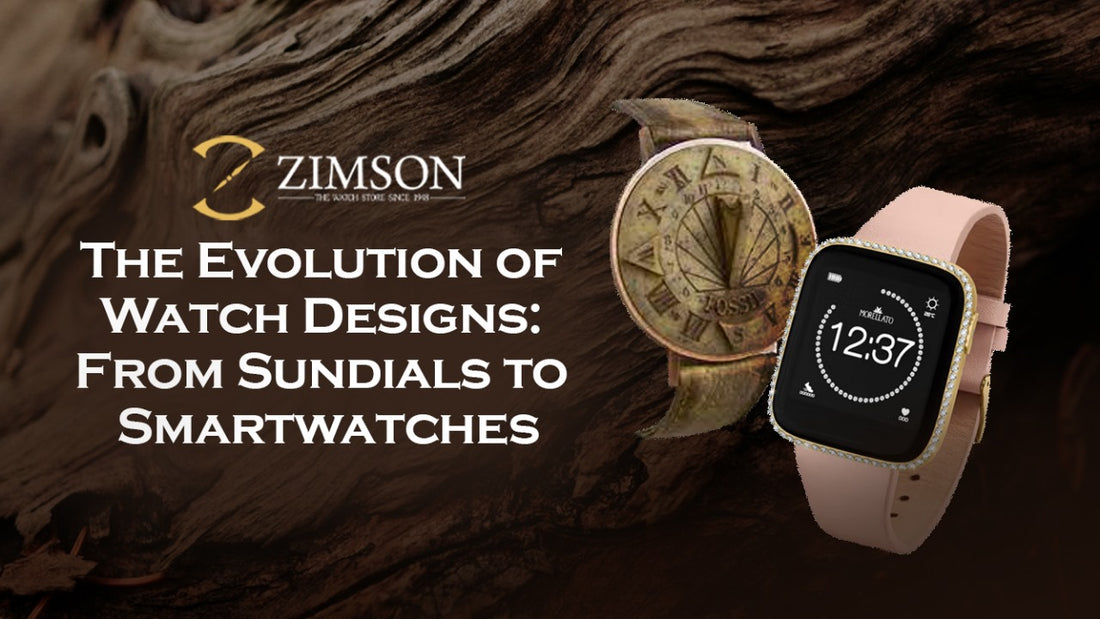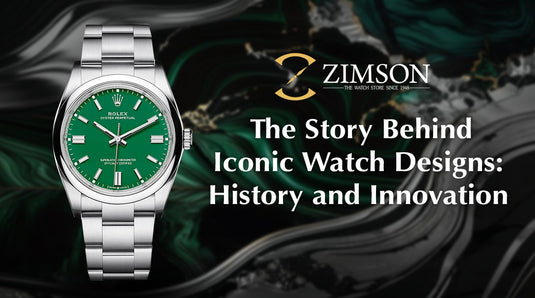
The Evolution of Watch Designs: From Sundials to Smartwatches
In the vast, multifaceted universe of horology, the journey from the rudimentary sundials of ancient civilizations to the technologically advanced smartwatches of the 21st century is nothing short of a marvel. Watches, initially conceived as basic tools to track the sun's movement and demarcate the hours of the day, have transformed dramatically, echoing the progress of human civilization itself. Today, these timepieces are not just functional devices but are emblematic of luxury, style, and the pinnacle of technological advancements.
For aficionados and enthusiasts, a watch is not just a time-telling instrument strapped to the wrist. It is a piece of art, a symbol of status, and a reflection of history. These individuals, with their discerning tastes, view watches as cherished heirlooms that weave tales of human innovation, unparalleled artistry, and the undying quest for perfection. Every subtle movement of a watch's hand, the lustrous shine of its casing, and the intricate dance of its internal gears tell stories of epochs gone by, of master craftsmen's dedication, and of innovations that pushed the boundaries of what was deemed possible.
This exposition aims to take its readers on a mesmerising voyage through the annals of watch design evolution. It seeks to spotlight significant junctures that have defined this evolution, celebrating the genius of artisans and pioneers whose contributions have etched an everlasting impact on horological artistry. A particular focus will be directed towards the prestigious brands that find pride of place in the collection of Zimson Watches. This esteemed establishment is not just a purveyor of timepieces but is a beacon of elegance, class, and sophistication in the world of horology.
The annals of timekeeping trace back to ancient civilizations, where man, in his primal quest to understand the cosmos, looked skyward. Sundials, using the sun's shadow, were among the first tools to demarcate the day. Sandglasses and water clocks came next, each of which was better than the last but had limitations due to its age. However, as centuries rolled on, the Renaissance period saw a surge in scientific curiosity and mechanical ingenuity. This era birthed the first mechanical clocks, grandiose structures that adorned town squares, ringing out the hours and becoming symbols of communal pride. The subsequent invention of the pocket watch in the 16th century marked a significant leap, making timekeeping personal and portable.
The 20th century, often hailed as the golden age of watchmaking, witnessed the Swiss dominate the horological scene. Their meticulous craftsmanship, attention to detail, and relentless pursuit of precision set them apart. Brands like those showcased in Zimson Watches' collection became synonymous with luxury and precision. The Swiss mastery of watchmaking became the gold standard, a benchmark for others to aspire to.
Yet, the world of watches was set for another upheaval with the advent of the quartz movement in the 1970s. This technology, using quartz crystal's vibrations, made watches more affordable and accurate. While purists debated its impact on traditional watchmaking, there was no denying the democratisation of timekeeping.
Today, as we stand on the cusp of technological advancements, smartwatches have entered the fray, merging traditional aesthetics with modern functionalities. These devices, while offering a plethora of features, also pay homage to the artistry of yesteryear
.
Zimson Watches, in its curated collection, captures this entire spectrum. From timeless classics that echo the grandeur of the past to modern masterpieces that represent the zenith of technological advancements, Zimson offers a palette for every connoisseur. It's a place where history, art, and innovation converge, all within the elegant confines of a watch's bezel.
The Dawn of Timekeeping: Sundials and Water Clocks
In the grand tapestry of horological history, the narrative commences with the sundials, the brainchild of ancient civilizations. These elementary yet profound instruments, dependent on the sun's mercurial dance and the consequent shadow it cast, represented humanity's inaugural foray into the intricate domain of chronometry. Sundials, while emblematic of the ingenuity of their epoch, bore an inherent limitation: their reliance on the sun's benevolence. The absence of sunlight during overcast days or the enigmatic embrace of the night rendered them dormant, highlighting the need for a more consistent timekeeping mechanism.
Emerging from this necessity were the water clocks, known in the annals of history as 'clepsydrae'. These sophisticated apparatuses, harnessing the unerring flow of water between vessels, offered a solution to the sundial's limitations, providing a more unwavering measure of time's relentless march. It was the indomitable spirit and unparalleled craftsmanship of civilizations like the Greeks and Chinese that led to monumental enhancements in the design, functionality, and precision of these water clocks. Their contributions laid the foundational stones for the horological marvels that were to follow.
Drawing a parallel to the meticulous craftsmanship of ancient civilizations, modern watchmaking brands, such as those curated by Zimson Watches, embody a similar pursuit of perfection. Brands like Rolex, with their unwavering commitment to precision and innovation, can be seen as the modern-day successors to the ancient horologists. Their timepieces, much like the clepsydrae of yore, are a testament to mankind's relentless quest to capture, measure, and understand the essence of time. Each tick of a Rolex echoes the same dedication and artistry that the Greeks and Chinese infused into their water clocks, bridging the chasm of time with the thread of craftsmanship.
The Mechanical Revolution: Birth of the Wristwatch
The dawn of mechanical engineering heralded a transformative era in the annals of timekeeping. As the world transitioned from the mediaeval to the Renaissance period, the first mechanical clocks, architectural marvels in their own right, began to dominate the skylines of European town squares. These monumental edifices were not merely functional; they stood as testaments to human ingenuity, craftsmanship, and the insatiable quest for precision.
Yet, the true pinnacle of this mechanical renaissance was realised in the 16th century with the conceptualization and creation of the pocket watch. This was not just a miniaturised timekeeping device; it symbolised the confluence of art and engineering. Encased in ornate designs, often crafted from precious metals and adorned with gemstones, the pocket watch became an emblem of status, sophistication, and personal luxury. Brands, akin to those showcased in Zimson Watches' esteemed collection, began their foray into crafting these exquisite timepieces, further elevating their allure.
However, the world of horology was on the cusp of yet another monumental shift. The transition from the pocket watch to the wristwatch marked a significant evolution in both design and societal norms. Initially, wristwatches were perceived as feminine adornments, often embellished with intricate designs and precious stones, making them more of a decorative jewellery piece than a functional timekeeper. But as the pages of history turned to the late 19th and early 20th centuries, the practicality of wristwatches began to shine, especially in the demanding environments of warfare.
Soldiers, navigating the treacherous terrain of battlefields, found the wristwatch to be an indispensable ally. The ease of glancing at one's wrist, as opposed to fumbling for a pocket watch amidst the chaos of combat, made wristwatches an essential gear. Recognising this shift, esteemed brands, reminiscent of those partnered with Zimson Watches, began crafting robust, precise, and durable wristwatches. These timepieces, while functional, did not compromise on elegance, ensuring that even in the harshest of conditions, style and sophistication remained paramount.
In essence, the journey from towering mechanical clocks to the personal luxury of wristwatches is a captivating tale of innovation, artistry, and adaptation, further enriched by the contributions of illustrious brands that have left an indelible mark on the world of horology.
The Golden Era: Swiss Mastery and Luxury Timepieces
The 20th century stands as a monumental epoch in the annals of horological history, with Switzerland ascending to unparalleled prominence as the very heart and soul of watchmaking brilliance. This era, often referred to as the golden age of horology, witnessed the Swiss maestros crafting masterpieces that seamlessly blended artistry with engineering prowess.
Brands such as Rolex, a crown jewel in Zimson Watches' meticulously curated collection, became the very embodiment of opulence, precision, and artisanal excellence. Rolex, with its iconic timepieces, set benchmarks that few could rival. Each watch, meticulously crafted, bore testimony to the brand's unwavering commitment to perfection and its pursuit of horological supremacy.
But the Swiss Renaissance was not limited to just one brand. Zimson Watches, with its discerning eye, also brought into its fold other luminaries of the watchmaking world. Brands that, like Rolex, have left an indelible mark on the horological landscape with their groundbreaking innovations, unparalleled craftsmanship, and timeless designs Each timepiece resonated with tales of dedication, passion, and the relentless quest for perfection.
The designs of these Swiss masterpieces were not just about aesthetics; they were a harmonious amalgamation of form and function. The intricate detailing, the choice of the finest materials, and the precision of their mechanical movements set them apart. It was this combination of beauty and brains, design and durability, that elevated Swiss watches to an echelon where they were revered not just as instruments of timekeeping but as objets d'art.
In essence, the 20th century, with Switzerland at its helm, redefined the paradigms of watchmaking. And establishments like Zimson Watches, by showcasing these iconic brands, have ensured that connoisseurs and enthusiasts can experience and own a piece of this rich legacy, a testament to an era when timekeeping was transformed into an art form of the highest order.
The Quartz Revolution and Beyond
The 1970s heralded a pivotal moment in the annals of horology with the advent of the quartz revolution. This epochal shift saw the traditional mechanical movements, which had been the heartbeat of timepieces for centuries, being supplanted by battery-powered quartz oscillators. This groundbreaking innovation brought with it a slew of advantages, most notably enhanced accuracy and affordability. Watches, once the preserve of the elite, became accessible to a broader audience, democratising luxury in a sense.
However, this seismic shift was not without its detractors. Purists and connoisseurs of traditional watchmaking viewed the quartz movement with a degree of scepticism, if not outright disdain. To them, the very soul of a watch lay in its intricate mechanical movements, each gear and spring a testament to human ingenuity and craftsmanship. The quartz movement, with its electronic precision, was seen by some as an affront to this legacy, sparking fervent debates about the essence and ethos of genuine watchmaking.
Fast forward to the present era, and the horological landscape is once again in the throes of a transformative phase with the emergence of smartwatches. These contemporary marvels, while undeniably at the cutting edge of technology, strive to strike a harmonious balance between the age-old aesthetics of traditional watch design and the multifaceted functionalities of modern devices. Beyond mere timekeeping, they offer an array of features, from fitness tracking to instant notifications, making them indispensable companions in today's digital age.
Zimson Watches: A Testament to Timeless Elegance
In the illustrious world of horology, Zimson Watches emerges as a beacon of unparalleled elegance and sophistication. With a collection that is both curated and revered, Zimson is not merely a purveyor of timepieces but a custodian of history, artistry, and innovation. Each watch, meticulously selected, is a testament to the brand's commitment to excellence and its unwavering dedication to the craft.
At the heart of Zimson's collection lies the iconic Rolex, a brand that has become synonymous with luxury, precision, and timeless design. A Rolex is not just a watch; it is a narrative, a chronicle of human ingenuity, and a symbol of an enduring legacy. It speaks of centuries-old traditions melded with cutting-edge technology, resulting in creations that are both awe-inspiring and eternally stylish.
But the Zimson narrative doesn't end with Rolex. The collection is a veritable tapestry of brands, each with its own unique story and heritage. These brands, each a titan in its own right, bring to the fore a diverse range of designs, mechanisms, and histories. From the intricate complications of Tissot that echo the grandeur of bygone eras to the sleek modernity of Chopard that encapsulates contemporary elegance, Zimson's collection is a horological tour de force.
For the discerning collector, a visit to Zimson is akin to a journey through time. Each timepiece, cradled within the luxurious confines of Zimson's showcases, whispers tales of design evolution, technological marvels, and the masterful craftsmanship of artisans who have dedicated their lives to the art of watchmaking. These are not mere watches; they are heirlooms, treasures that carry with them the weight of history and the promise of the future.
Conclusion
The journey of watch designs, from the simple sundials of yore to the smartwatches of today, is a testament to mankind's relentless pursuit of innovation, precision, and beauty. This evolution is not merely a chronicle of technological advancements but a reflection of humanity's intrinsic desire to capture the essence of time and give it form, function, and elegance. Watches, in their myriad forms, have always been more than mere instruments of timekeeping. They are, in essence, wearable art, each piece echoing the ethos of its era, the vision of its creator, and the aspirations of its wearer.
For collectors and enthusiasts, this journey is a profound experience. It's not just about tracking the fleeting moments but about immersing oneself in the art, history, and craftsmanship that each timepiece embodies. Every watch, from the most rudimentary to the most sophisticated, tells a story. It speaks of the challenges faced by its creators, the innovations they introduced, and the legacy they hoped to leave behind.
Esteemed establishments like Zimson Watches play a pivotal role in this narrative. They don't just offer timepieces; they curate experiences. With brands like Rolex, which finds pride of place in their collection, Zimson Watches bridges the past and the present. Rolex, with its timeless designs, unparalleled precision, and commitment to excellence, embodies the pinnacle of watchmaking. It's not just a brand; it's an institution, a testament to what is achievable when craftsmanship meets passion.
But the narrative doesn't end with traditional brands. As we stand on the cusp of a new era where technology and tradition intertwine, smartwatches represent the next chapter in this ongoing saga. They are a beacon of technological prowess, yet they pay homage to the artistry of traditional watchmaking. They remind us that while the tools and techniques may evolve, the core essence of watchmaking remains unchanged: to capture the beauty of time in its most tangible form.
In conclusion, as we marvel at the wonders of modern horology, it's essential to remember the journey, the milestones, and the visionaries who made it all possible. And establishments like Zimson Watches ensure that this legacy, this art, is not just preserved but celebrated, offering connoisseurs a chance to own a piece of history, art, and innovation, all encapsulated within the confines of a watch's bezel.







